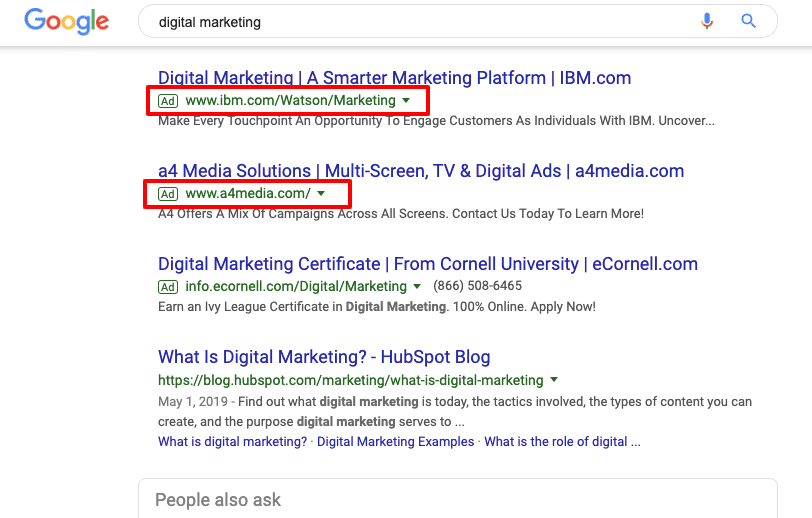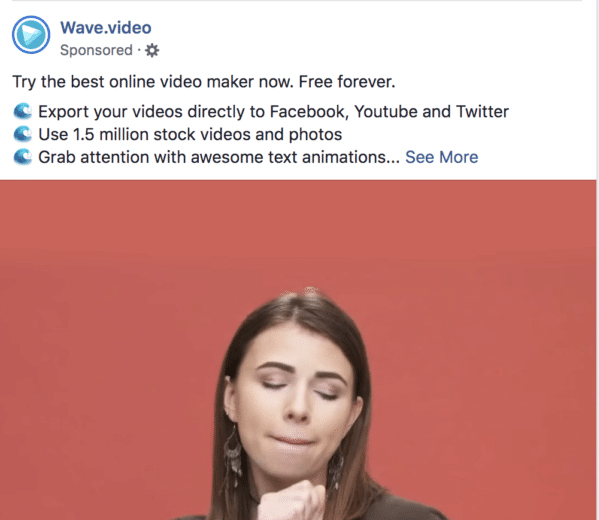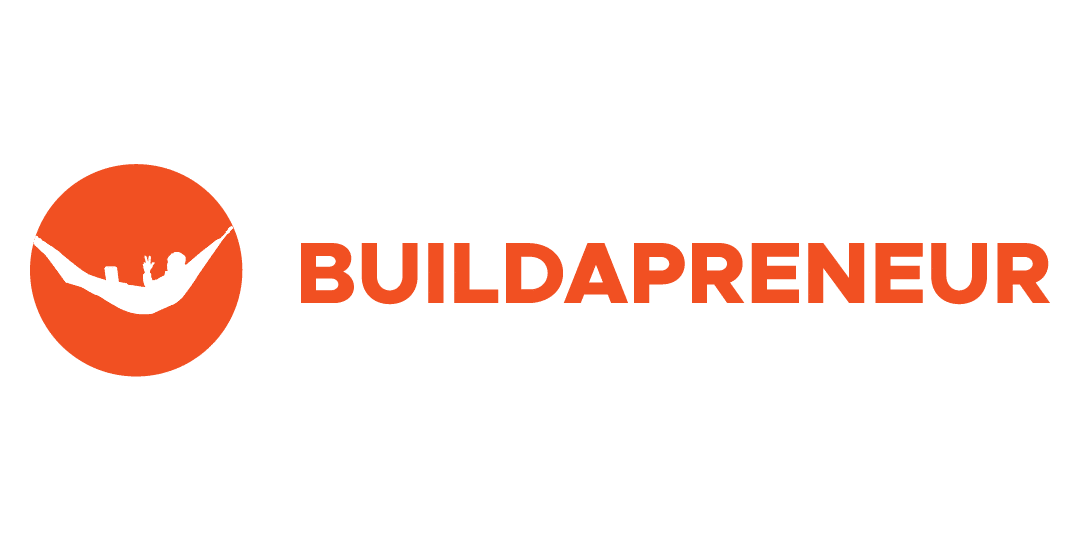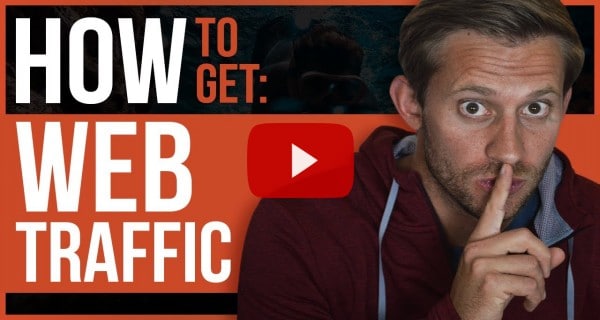Free Training!
The 3-step system I used to make 7-figures of Affiliate Commissions in my first 3 years as an affiliate marketer.
There are literally dozens of ways to generate website traffic online today. I know it can seem complicated, but getting a handle on the basics is quite easy. Then it just becomes a matter of mastering one source of traffic and some really crazy things can happen.
Things like your business exploding overnight and you having more customers than you know what to do with.
So let’s talk about how to get website traffic.
The whole internet (in terms of selling) can be broken down into two main areas: search and social. The strategies you use to gain traffic from these platforms can be summed up as paid vs organic.

In this post, I’m going to explain what search and social are all about, and how you can approach website traffic generation as a beginner.
Search vs Social
So, there are two main ways to reach your audience and attract web traffic online: search and social.
Search
Most people associate the word “search” with Google. It’s true that Google is the biggest search engines on the planet, where most people go to find new information. But it’s far from the only real search engine out there.
For traffic generation purposes, a search engine is a place people go to actively look for and find information about topics that interest them. Google and Bing are traditional search engines, but YouTube and Pinterest are other examples of platforms that make the cut. People use these tools to actively search for content and information.
When it comes to generating traffic to your website this is my personal favorite.
Here is why.
People that tend to come to search engines tend to be what I call “hot traffic”.
They are already actively doing something to try and solve their problem and often are more than willing to pay for a solution, assuming you have a good one.
Think about the last time you searched Google for something. If you found what you were looking for, were you prepared to take out your credit card and pay for it?
Sometimes no, but often yes.
Social
Social platforms can be a number of popular social networking sites. For traffic generation purposes, these include social platforms where people go to passively consume content. Facebook, Instagram, Snapchat, and Twitter are examples of social traffic generation channels.
The way people use search vs social platforms has a huge impact on how you can market to them for traffic generation:
• Search Engines — Here you target to solve problems. Aim to provide answers to the questions people are searching about.
• Social — Here you target through interruption. Nobody’s actively looking for your business on social, but you can still get traffic by targeting them with a marketing message relevant to their interests and needs.
Can you see why I prefer to focus on search traffic? They are people that are already recognizing a problem or desire they have and looking for a solution.
Social media traffic from sites like Instagram is the opposite.
Someone that hops onto Instagram and starts scrolling down rarely is looking to solve a problem, unless that problem is that they are tired and their brain hurts.
Instead they are just looking to turn off and chill their brain out for a little bit.
Getting that person to take action is much harder. You typically have to offer something for free, and then work your way up to a sale using ClickFunnels or another sales funnel builder.
Paid vs Organic
There are two main approaches you can use to reach your audience on search and social: paid or organic targeting. While you may already know what these mean, let me break it down.
Paid Search
Paid search involves paying for your content to rank well in search results. On Google and Bing, this is called pay-per-click (PPC) advertising. Type just about any business-related keyword into a search engine, and you’ll find PPC ads at the top of results:

The benefit of this type of advertising is that you can pay for hot, highly targeted traffic to come to your website. It is fast, it’s easy, and can literally start bringing results in a matter of minutes.
For example let’s say you sell pink women’s shoes.
You can target ads to people that search for “buy pink women’s shoes”.
How hard can it be to sell that person shoes, right?
Sort of.
The problem with this type of traffic is that it can be very expensive. Everyone that sells women’s shoes is going to be trying to get their ads in front of those people searching.
Search engines use an auction system to determine which advertisers get to actually show up. While it is not totally that simple, it essentially means that the highest bidder is who gets to show up.
This means that your margins can often be tiny, or even negative for the first while. Some companies won’t make their money back for months, or even years as they continue to sell the newly captured customer other products.
I’ve seen some industries where the cost just to get someone to click on your ad is close to $100 for a single click!
Organic Search
Organic search targeting involves optimizing your website content to appear in search results without paying for placement. This is a strategy called search engine optimization (SEO).
SEO basically involves creating content targeting long tail keywords that solve your audience’s problems. There are lots of great tools out there that can help you find long tail keywords to target related to your business niche.
You can also optimize for organic search on YouTube and other platforms using keyword targeting and tagging.
So to break it down.
To generate traffic to your website with SEO you need to create a blog. Then you need to do a lot of keyword research using tools like Ahrefs to figure out what people are searching for in your target market.
Next you will put content on your blog that answers the questions your target market is searching for.
You can go for really hot traffic like “best pink women’s shoes” and try to write an article that helps people see why your shoes are best.
Alternatively, you could write an article on “how to choose the best shoes for your girlfriend”. Then you could use the blog post to point them over to the shoes that you are selling.
While SEO can be relatively cheap if you do it yourself, it can be very time consuming. Typically your articles will not just rank overnight, nor will they rank without a lot of work put into making good content, and utilizing other ranking techniques.
It can also be risky if you put all your eggs into this basket because sometimes Google will update their algorithm and your website traffic might be cut in half overnight, as will your sales.
I recommend every business has an organic search engine plan in place, but that no business puts all their stock in that plan. It can be great once a post ranks to get traffic to your site every single month on autopilot, but don’t put your entire business’s future on it.
Paid Social
If you go to Facebook right now and scroll through your feed, you can easily find sponsored content:

The same probably goes for your Instagram or any other social media platform you use.
There are lots of ways you can pay to advertise your content on social media. Facebook’s Boost Post feature allows you to artificially “boost” the visibility of your organic content. Twitter’s Promoted Tweets work the same way. You can also create actual ads to appear on social platforms.
The problem with social media ads, as mentioned above, is you are targeting people that aren’t necessarily in the mood to be sold to. They are in the mood to turn off their brains. They aren’t hot website traffic, they are cold.
This means a successful social media advertising marketing strategy is usually a large campaign with multiple facets.
Advertisers will typically offer something free to catch people’s attention and suck them in. I’m sure I’m not the only one who has been a sucker for signing up for something for free from a Facebook ad.

Once you sign up for the free item, the advertiser tries to upsell to various other related items, or packages that cost money.
They also will start an email marketing campaign and a retargeting campaign to get you to buy the other products they offer that actually bring in money.
While these methods do work, they take a firm understanding of how various pieces of online traffic work together and the big picture of online marketing. They also take a lot of work to get everything in place and functioning smooth.
Organic Social
Organic social targeting involves optimizing your regular social posts to get traffic to your website. You can do this by posting interesting and engaging content to your social profile or Facebook Business page. For LinkedIn and Facebook, you can also get organic reach by posting to groups.
The idea is to share content that is discussion-worthy. Getting a lot of likes, comments and shares can help your content potentially get viral reach and get thousands of people clicking to your website.
Here are the issues I’ve ran into with organic social.
The first one is Facebook (and others) seem dead set on hurting your organic reach. Sounds crazy, but it’s all about money. The more organic reach you get, the less you will pay them to reach your audience (boosted posts and ads).
The second thing is that your sales-related posts will almost always get your least engagement, while your free stuff and random posts will get more. This is great for engagement, but your sales offer often doesn’t get shown to 90% of your audience.
So, while organic reach is a great way to get traffic to your website, it is definitely not a basket you want to put all your eggs in.
Where Should You Start?
To build a targeted, optimized traffic generation strategy, you shouldn’t try everything at once. Pick a channel and run with it, then expand your strategy down the road.
Search or Social?
So when trying to get traffic to your site, should you start out with, search engines or social? I personally prefer search engines, because you don’t have to interrupt your audience’s experience to convince them to buy. They’re already looking for information. You just have to solve the problems they want solved.
With social, you have to get people to spend a lot of money before you can get a return on your investment. So if you have a lot of strong products and a good email funnel, social is a great option to start with.
Organic or Paid?
If you don’t have a marketing budget yet and don’t have the money to spend on ads, then organic is a great place to start. Create targeted content and promote it the right way, and you’re bound to grow your website traffic base from organic search or social.
That said, ads are a powerful tool you can use to grow your website traffic exponentially. So once you have the budget, invest in paid promotion as well!
Teach Yourself Traffic Generation
I’m a self-taught entrepreneur. Everything I know about website traffic generation comes from my own experiences or the tools I used to teach myself. It’s easy enough to teach yourself search engine marketing or social media marketing through online courses.
I personally recommend Udemy. Udemy has a huge database of valuable courses that can teach you any of these things for $10, $20 or $30 a course.
If you want to learn about how to nurture your website traffic into paying customers, then check out my free course on sales funnel generation here at Buildapreneur.





